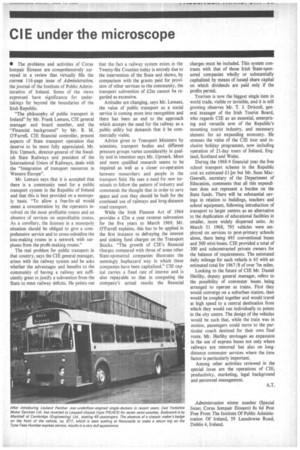CIE under the microscope
Page 41

If you've noticed an error in this article please click here to report it so we can fix it.
• The problems and activities of Coras Iompair Eireann are comprehensively surveyed in a review that virtually fills the current 116-page issue of Administration, the journal of the Institute of Public Administration of Ireland. Some of the views expressed have significance for undertakings far beyond the boundaries of the Irish Republic.
"The philosophy of public transport in Ireland" by Mr. Frank Lemass, CIE general manager and board member, and the "Financial background" by Mr. B. M. O'Farrell, CIE financial controller, present aspects of State transport operation that deserve to be more fully appreciated. Mr. Eric Upmark, director-general of the Swedish State Railways and president of the International Union of Railways, deals with the "Integration of transport resources in Western Europe".
Mr. Lemass says that it is accepted that there is a community need for a public transport system in the Republic of Ireland and that this is best provided on a monopoly basis. "To allow a free-for-all would mean a concentration by the operators involved on the most profitable routes and an absence of services on unprofitable routes. As a corollary, the licensee in a monopoly situation should be obliged to give a comprehensive service and to cross-subsidize the loss-making routes in a network with surpluses from the profit-making routes."
The real problem for public transport in that country. says the CIE general manager, arises with the railway system and he asks whether the advantages and benefits to the community of having a railway are sufficiently great to justify a subvention from the State to meet railway deficits. He points out that the fact a railway system exists in the Twenty—Six Counties today is entirely due to the intervention of the State and shows, by comparison with the grants paid for provision of other services to the community, the transport subvention of £2m cannot be regarded as excessive.
Attitudes are changing, says Mr. Lemass, the value of public transport as a social service is coming more into recognition and there has been an end to the approach which accepts the need for the railway as a public utility but demands that it be commercially viable.
Advice given to Transport Ministers by scientists, transport bodies and different pressure groups varies considerably in quality and in intention says Mr. Upmark. More and more qualified research seems to be required as well as a closer co-operation between researchers and people in the transport field. He sees a need for new terminals to follow the pattern of industry and commends the thought that in order to save space and cost they should be built for the combined use of railways and long-distance road transport.
While the Irish Finance Act of 1964 provides a £2m a year revenue subvention for the five years to March 1969. Mr. O'Farrell explains, this has to be applied in the first instance to defraying the interest and sinking fund charges on the Transport Stocks. "The growth of C1E's financial charges compared with those of some other State-sponsored companies illustrates the seemingly haphazard way in which these companies have been capitalized." CIE capital carries a fixed rate of interest and is also repayable so that in computing the company's actual results the financial charges must be included. This system contrasts with that of those Irish State-sponsored companies wholly or substantially capitalized by means of issued share capital on which dividends are paid only if the profits permit.
Tourism is now the biggest single item in world trade, visible or invisible, and it is still growing observes Mr. T. J. Driscoll, general manager of the Irish Tourist Board, who regards CIE as an essential, enterprising and versatile arm of the Republic's mounting tourist industry, and necessary element for an expanding economy. He stresses the value of the CIE tour and inclusive holiday programme, now including operation of 21-day tours of Ireland, England, Scotland and Wales.
During the 1968-9 financial year the free school transport scheme in the Republic
cost an estimated but Mr. Sean MacGearailt, secretary of the Department of Education, comments that all this expenditure does not represent a burden on the State funds. There will be substantial savings in relation to buildings. teachers and school equipment, following introduction of transport to larger centres as an alternative to the duplication of educational facilities in smaller, more widely dispersed units. At March 31 1968, 795 vehicles were employed on services to post-primary schools alone, there being 495 conventional buses and 300 mini-buses. CIE provided a total of 300 and subcontracted private owners for the balance of requirements. The estimated daily mileage for each vehicle is 65 with an estimated total for 1967/8 of over 7m miles.
Looking to the future of CIE Mr. Daniel Herlihy, deputy general manager, refers to the possibility of commuter buses being arranged to operate as trains. First they would converge on a suburban station, then would be coupled together and would travel at high speed to a central destination from which they would run individually to points in the city centre. The design of the vehicles would be such that, while the train was in motion, passengers could move to the particular coach destined for their own final route. Mr. Herlihy envisages an expansion in the use of express buses not only where railways are removed but also on longdistance commuter services where the time factor is particularly important.
Among other activities reviewed in the special issue are the operations of CIE, productivity, marketing, legal background and personnel management.
A.T.
























































































































































